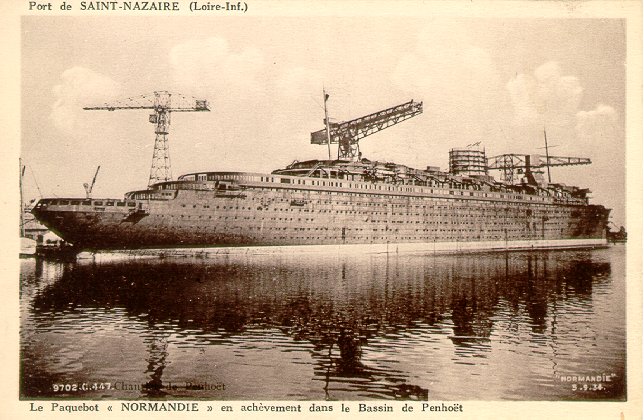The French Line's Normandie is one of the relatively few legitimate
contenders for the title "Greatest Liner Ever". She was a ship of
superlatives: the largest ship in the world for five years, more than
20,000 tons larger than White Star's Majestic; the first liner to exceed
1000 feet in length; the first liner to exceed 60,000 tons (and 70,000
and 80,000, for that matter); the largest turbo-electric powered liner;
and the first to make a 30 knot eastbound Atlantic crossing. All told,
Normandie earned the Blue Riband for five record-breaking crossings;
twice westbound and three times eastbound, including both legs of her
maiden voyage. And yet, all these technical qualities are only part of
Normandie's greatness; her design and decor were equally innovative,
distinctive and luxurious. All of these factors contributed to her
being described as "the ultimate ocean liner---definitely of the 1930s
and possibly of the century". (Braynard and Miller's Fifty Famous
Liners.) And, in the end, her demise was as ignominious as she herself
was glorious.
Built by Chantiers et Ateliers de St. Nazaire and launched in 1932,
Normandie made her maiden voyage from Le Havre to New York on 29 May
1935, setting speed records both westbound and eastbound. She was
overhauled during the winter of 1935-36 to correct significant vibration
problems which were evident from the time of her maiden voyage. (In the
process, her gross tonnage was increased from 79,280 to 83,423. This
permitted her to remain the largest liner even after Cunard White Star's
Queen Mary, 81,235 tons, entered service in May 1936.)
Normandie's career as a passenger liner was cut short by the outbreak of
World War II. At the end of her 139th Atlantic crossing, she arrived in
New York on 28 August 1939, and would never sail again. Mothballed at
Pier 88, she was taken into custody by the U.S. Coast Guard when France
was occupied in June 1940, and less than a week after Pearl Harbor she
was taken over by the U.S. Maritime Commission and was renamed U.S.S.
Lafayette.
In January 1942 the U.S. War Department took her over and by 9 February
her conversion into a troopship was nearly completed. But on that date,
while she was being loaded with supplies, a spark from a welder's torch
ignited a bale of lifejackets. The fire spread rapidly, and a series of
mistakes by the ship's crew and firefighters led to the ship's turning
on her port side and sinking at her berth. The stern slipped under Pier
88, while the bow moved close to the adjacent Pier 90. Refloated in
September 1943, she was then towed to the Brooklyn Navy Yard. Plans to
convert her into an aircraft carrier were abandoned as too costly, and
she remained in Brooklyn for the balance of the war. Unwanted and
unusable, she was scrapped in Newark, NJ, in 1946-47, the last pieces of
steel being removed by rail on 6 October 1947.
Sources: Braynard and Miller's Fifty Famous Liners; Beken of Cowes Ocean
Liners; Haws' Merchant Fleets; Bonsor's North Atlantic Seaway.

